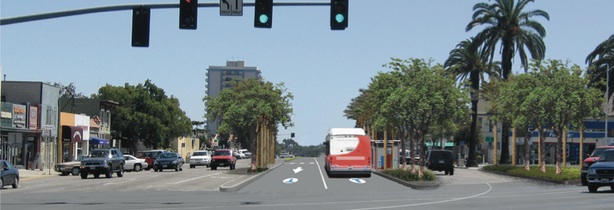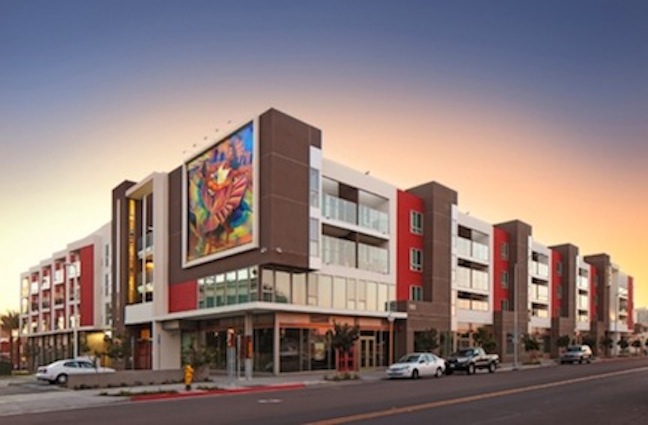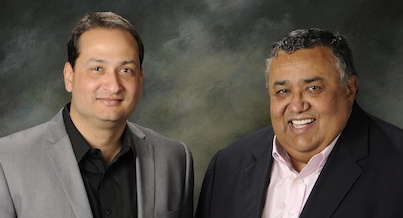Daily Business Report-June 10, 2013
Joe Fernandez and Ramon Castillo of CMF Global
Chula Vista Company Named
Small Business Exporter of the Year
The San Diego District Office of the U.S. Small Business Administration selected CMF Global Inc. of Chula Vista as the 2013 Small Business Exporter of the Year. CMF Global will be honored at Wednesday’s Small Business Awards luncheon at the Scottish Rite Event Center in Mission Valley.
CMF Global is a supplier of pipe, valves, fittings and wire used for water transmission and distribution, approved fire suppression systems, sewer systems, oil and gas applications, industrial and mining applications, drainage and irrigation systems. Since its inception in 2002, the company has promoted the export of U.S. products made by more than 30 manufacturers. They sell products in 38 countries around the world.
Ramon Castillo and Joseph Fernandez own and operate the company. Their success, they say, has been due to their ability to consolidate many items into a single order; simplify the procurement process and assist customers in obtaining financing for large purchases of U.S. manufactured products.
CFM Global also received the 2012 Exporter of the Year Award at the International Business Leadership Ceremony held at the World Trade Center in San Diego.
A pre-luncheon conference will feature a variety of free workshops on small business financing, credit repair and government contracting, as well as providing an opportunity for small businesses interested in government contracting to meet the buyers. Register at www.sandiegosmallbiz.com. Luncheon seats are available for $50 each or $350 for a table of eight. For information, contact the North San Diego Small Business Development Center at (760) 795-8740.

Construction on Mid-City Rapid Bus Line Begins This Month
SANDAG is set to begin construction this month on the mid-city rapid bus project. The bus line, funded by the region’s TransNet sales tax, will speed up transit from San Diego State University to downtown via El Cajon and Park boulevards. The new route will have fewer stops, synchronized lights and, in some spots, separate bus lanes in the median. SANDAG officials say it should feel like using the trolley, just without the tracks. “It’s a new type of bus line that we really haven’t done in San Diego yet,” said SANDAG director of mobility Jim Linthicum. “It’ s going to be a bus that has a lot of design elements and features that resemble what the trolley has.” Bus stops along the route — many currently consist of signs with schedules — will get makeovers, adding shelters, seats, landscaping and more gathering space. They’ll be some of San Diego’s first stops to offer digital, real-time tracking of buses.
There’s broad support for the project in City Heights, where residents have been vocal about needing more transit. Many students in the neighborhood rely on the bus to get to City College and SDSU. It will also intersect Centerline, a long-awaited bus line that will connect residents to job centers along Interstate 15.
But Beth Jaworski, the vice chair of Uptown Planners, the advisory board that oversees land use decisions from Mission Hills to University Heights, said there’s still opposition in Hillcrest. “Most of the seniors living in this area don’t have cars and you’d think that, well, rapid bus would be a boon for them,” Jaworski said. “But they’re some of the most vocal opponents to it.” Residents in three senior facilities on Park Boulevard said they’re worried about safety. Instead of boarding the bus at stops just outside their front doors, they’ll have to cross busy lanes of traffic to board in the median. SANDAG will hold informational meetings at 5:30 tonight at Grace Lutheran Church and 5:30 p.m. Thursday at 3727 El Cajon Blvd.
San Diego Police Ratify Labor Deal With City
San Diego police officers ratified a five-year labor deal with the city of San Diego, becoming the second major union to agree to the pact, the San Diego Police Officers Association announced Friday. Officers have been leaving the department for nearby agencies in large numbers in recent years, with SDPD leaders telling council members recently that the departed have increased their take-home pay by $1,000 to $1,500 per month. The deal calls for POA members to receive a 2 percent pay increase in the fiscal year that begins July 1, a 1 percent hike the following year, and 2 percent uptick the year after that. Officers will receive 1 percent raises in each of the last two years of the contract. (Reported by City News Service)
ScaleMatrix Partners With Dell
San Diego’s ScaleMatrix, a leader in the growing world of cloud computing and the data center market, has been chosen as one of three companies to work with Dell and deliver their cloud services. ScaleMatrix will contribute to Dell’s services with its VMware-based TruCore Performance Cloud hosting platform. The company said this provides users with enhanced control over functionality and performance.
What’s the Cost of Power After San Onofre?
How much will it cost to power your home now that San Onofre is offline for good? Short answer: possibly more, reports KPBS. The San Onofre Nuclear Generating Station shut down in January of 2012 prompted a rise in wholesale power prices that has persisted through 2013, according to a study released by the U.S. Energy Information Administration in March. Now, as Southern California Edison prepares to shut down the power plant on the San Clemente coast, it’s unclear what will happen to individual power prices. According to the EIA study, the wholesale price per megawatthour — the amount of electricity used to power about 330 homes in a single hour — jumped to more than $50 from about $30. The study notes that “Southern California power prices have persistently exceeded Northern California prices.” It also notes that “Southern California needs to use local generation sources and cannot solely rely on imported electricity to replace generation from SONGS.” Alternatives to SONGS, according to the study, are more expensive and will likely contribute to higher prices in the future. Check out the entire report here.
www.eia.gov/todayinenergy/detail.cfm?id=10531

Spurlock Poirier Landscape Architects Receives Awards for the Mercado del Barrio Residential/Commercial Development
Spurlock Poirier Landscape Architects of San Diego has been honored by the San Diego Architectural Foundation and the San Diego section of the American Planning Association for its work on Mercado del Barrio, a residential and commercial development spanning 6.6 acres in the heart of San Diego’s Barrio Logan.
Spurlock Poirier was recognized with an “Outstanding Planning Project” award from SDAPA. The Mercado received the 2013 Community Vision Award from the San Diego Architectural Foundation. The award recognizes outstanding urban infill projects, encourages community collaboration and promotes the implementation of sustainable, “smart growth” practices in revitalizing urban areas.
“Mercado del Barrio is reminiscent of my hometown in San Luis Potosi, Mexico,” said Associate Principal Rocio Gertler. “The project is highly adaptable and fits well into the surrounding community.”
Spurlock Poirier, working with Safdie Rabines Architects, conceived of Mercado del Barrio to honor the neighborhood’s rich cultural history, promote the arts and encourage local business. Designed as a neighborhood hub, the mixed-use, transit-oriented development connects Chicano Park to the San Diego Bay and incorporates a large plaza, affordable housing, commercial space, a community center, a Latin grocer, and a multitude of retail options and open spaces. Mercado del Barrio also features an interactive water feature and splash pad, as well as a performance stage and seating. The LEED-certified project includes sustainable measures, such as porous pavers, a bioswale for stormwater collection and treatment, drought tolerant planting and over 100 new shade trees to reduce urban heat island effect.


